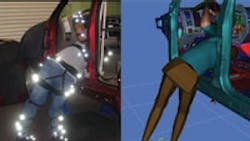The age-old wall that has existed between those that engineer products and those that mass produce them is rapidly shrinking. What's helped? Surprisingly enough... video games.
Ford Motor Co. is now designing all its vehicles from the ground up utilizing virtual manufacturing technology. The system, based off Siemens' product lifecycle management software, allows designers and engineers to collaborate from the beginning of a product program using computer-aided design data to digitally piece together the vehicle and optimize the final assembly process.
The Ford Fiesta, for example, which is on sale in Europe now and will be arriving in the United States this summer as a 2011 model, was designed and assembled using virtual manufacturing to study componentry and optimum manufacturing techniques.
"Literally, part by part, process by process, our product engineers and manufacturing engineers sat together watching a computer screen, making sure we agreed on the design and process, all in the digital phase," says Bruce Hettle, Ford's executive director of manufacturing engineering.
When the engineers were ready to move to the physical build phase, Hettle says there were only 10 manufacturing items that required attention, a staggeringly small percentage at such an early phase in the production process.
To better understand movement and stress levels, Ford dresses a worker in a suit covered with reflective balls, allowing digital cameras to pick up the motion, which is then translated to a computerized avatar.
Ford has employed virtual manufacturing to address health and safety as well. The system uses motion-capture technology, similar to those employed by the film and videogame industry to create virtual humans, or "avatars."
Hettle says the technology doesn't just create digital representations of people, but also captures skeletal and muscular structures, along with measuring movement and stress levels. To bring an avatar to life, a person is dressed in a suit covered with reflective balls. As the test subject moves, digital cameras pick up the motion, which is then translated
to a computerized avatar.
When heavy components have to be installed by assembly plant workers, Ford uses avatars to evaluate the efficiency of a process, as well as formulate the best range of motions to reduce risk of injury and fatigue.
"We simulate in all the processes the largest male employee and the smallest female employee, using precise technology models and algorithms and check for reach extensions, the posturing of the employee and exertion force," says Hettle.
Ford began using virtual manufacturing in 2003 in limited applications on the Focus line of automobiles. Hettle estimates that only 10% of the design was virtually analyzed. But in the last seven years, the technology has been absorbed throughout its production process -- including that of several of its leading suppliers (which Hettle declined to name).
Ford uses a computer-generated avatar performing an assembly line task to evaluate the efficiency of a process, as well as formulate the best range of motions to reduce risk of injury and fatigue.
See Also
